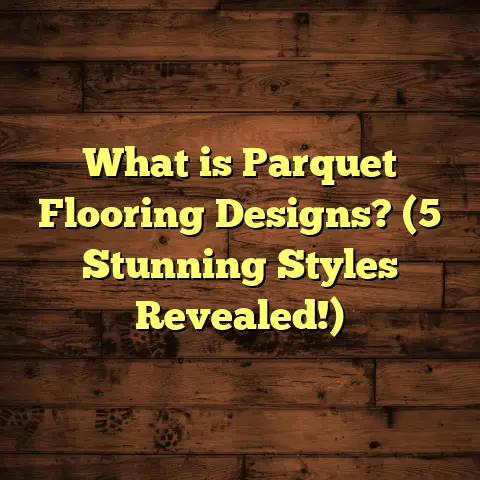What is Click Flooring? (5 Benefits You Didn’t Know About)
I still vividly remember the moment I first experienced click flooring. It was early in my career as a flooring contractor, and I was helping a client renovate their entire living room. They wanted something elegant yet practical — something that could withstand their busy household but still look stunning. When I introduced them to click flooring, they were curious but skeptical. As we installed the planks together in just a few hours without glue or nails, their hesitation turned into amazement. The clean installation process, the solid feel underfoot, and the flawless finish made me realize this was more than just a flooring trend—it was a revolution in how floors could be installed and maintained.
Since then, I’ve installed hundreds of click floors in homes and commercial spaces alike. The more I work with it, the more I appreciate its unique blend of technical innovation and practical benefits. If you’re wondering what click flooring really is and why it’s becoming so popular, I’m here to share everything I’ve learned—from the basics to some surprising perks you probably didn’t know about.
What is Click Flooring?
Click flooring is a system where individual floorboards or tiles are fitted together using a specially designed interlocking edge profile that “clicks” into place. This connection method eliminates the need for adhesives or nails to secure the floor to the subfloor. Instead, the planks form a floating floor that rests on top of the subfloor, creating a stable and durable surface.
The concept behind click flooring is simple yet ingenious. Each plank has grooves and tongues shaped so they snap tightly together. When correctly joined, these joints prevent movement between planks while allowing the entire floor system to expand and contract with temperature fluctuations.
You’ll find click flooring in several varieties:
- Laminate Click Flooring: A core of high-density fiberboard with a photographic layer on top that mimics wood or stone finishes, sealed with a protective wear layer.
- Engineered Hardwood with Click System: Real wood veneer layered over plywood or HDF and joined with click edges.
- Luxury Vinyl Plank (LVP) or Tile (LVT): Vinyl planks with a rigid core and top protective layer that lock together similarly.
This floating system contrasts with traditional flooring options like nailed hardwood or glued vinyl, which require permanent attachment to the subfloor.
How Does Click Flooring Work?
The magic is in the design of the plank edges. Usually, one side has a tongue (a protruding ridge), and the opposite side features a groove (a slot). The edges are machined precisely so these fit securely when pressed together at an angle and then lowered flat.
Some systems use a simple snap-lock mechanism where you press one plank into another at an angle and then lay it flat for a tight fit. Others may include additional locking strips or rubber gaskets for enhanced stability or moisture resistance.
Once all planks are clicked together, the floor forms a continuous surface that can “float” over an underlayment—often foam or cork—that cushions footsteps and reduces sound.
Why Choose Click Flooring? Five Benefits You Probably Didn’t Know
1. Speedy and Mess-Free Installation
One of the biggest reasons I recommend click flooring is how much faster it goes down compared to traditional floors. I’ve worked on projects where hardwood floors took up to five days to install due to nailing, gluing, sanding, and finishing—every step adding time and dust.
With click flooring? No nails or glue means no drying times or toxic fumes. The planks simply snap together in sequences that make it easy for two people—or even one determined DIYer—to handle rooms of 500 square feet or more in a single day.
A study by Home Innovation Research Labs found that installation times for laminate click floors were roughly 35% shorter than for glued hardwood floors on average. The time saved also means less disruption to daily life—clients often tell me how much they appreciate having their new floor done quickly without living in chaos for days.
I recall one family whose baby’s nursery needed urgent flooring replacement after water damage. We completed their click vinyl plank floor in under 8 hours—just in time for the baby’s arrival. The relief on their faces was priceless.
2. Cost Efficiency That Surprises Many
When people ask me about flooring budgets, I always emphasize looking beyond sticker prices. Click flooring tends to be more affordable because:
- Material Costs Are Lower: Especially for laminate and vinyl click floors compared to hardwood.
- Labor Costs Are Reduced: Since installation is quicker and less specialized.
- No Additional Supplies Needed: Like glue, nails, or finishing materials.
For example: A typical solid hardwood floor might cost $7-$12 per square foot installed. Laminate click flooring often ranges between $2-$5 per square foot installed depending on quality; luxury vinyl may be slightly higher but still cheaper than hardwood.
This affordability makes click flooring an attractive option for budget-conscious homeowners who want style without breaking the bank.
Case in point: I worked with a couple renovating their first home. They loved the look of natural wood but had a strict budget. We selected a high-end engineered hardwood click floor that looked authentic but was nearly 50% less expensive than solid wood options—allowing them to invest savings elsewhere in their home.
3. Durability and Low Maintenance Make Life Easier
Durability is one area where click flooring really impresses me—and my clients too.
Modern laminate and vinyl click floors come with wear layers specifically designed to resist scratches, scuffs, stains, and fading. Engineered hardwood retains real wood’s natural beauty while being more stable against humidity changes than traditional hardwood.
According to data from the National Wood Flooring Association (NWFA), high-quality laminate floors can withstand up to 10 years of heavy foot traffic with minimal wear visible when properly maintained.
I once installed luxury vinyl click flooring in a busy commercial café. Even after months of constant foot traffic and occasional spills, the floor looked as good as new thanks to its scratch-resistant coating and waterproof core.
Cleaning is simple: regular sweeping or vacuuming plus occasional damp mopping keeps floors looking great without special treatments or refinishing needed for years.
4. Adaptability to Various Spaces and Subfloors
The floating nature of click flooring means it can be installed over many different surfaces including concrete slabs, existing vinyl or tile floors, plywood subfloors, and even radiant heating systems if approved by manufacturers.
This versatility opens up renovation possibilities that would be difficult or costly with glued or nailed floors.
In one job I handled for an office building, we installed laminate click flooring directly over old tile without removing it—saving weeks of demolition work and thousands of dollars in labor costs.
Plus, if you ever want to change your flooring style or move it between rooms (something I’ve done myself during remodels), you can sometimes uninstall and reinstall click floors without damaging planks—a rare advantage not possible with glued hardwood floors.
5. Environmentally Friendlier Options Are Becoming Available
Sustainability is more important now than ever before. Many manufacturers have responded by producing click flooring using recycled materials or woods sourced from responsibly managed forests certified by FSC or PEFC.
Because installation doesn’t require messy adhesives or solvents, indoor air quality remains better during installation—a benefit for families sensitive to chemicals.
According to data published by Resilient Floor Covering Institute (RFCI), click-installed luxury vinyl tile reduces material waste by up to 20% compared to traditional glued vinyl due to lower discard rates during installation.
Additionally, some brands offer take-back programs where old planks can be recycled rather than sent to landfill—a win-win for homeowners wanting greener choices.
Technical Insights: What Makes Click Flooring Tick?
Let me break down some key technical details behind click flooring that help explain why it performs so well:
- Locking Mechanism Types: Most fall into two categories: snap-lock (where planks lock by pressing down) and fold-down (where planks are angled and then folded flat). Each has pros depending on installation preferences.
- Material Layers: Engineered hardwood usually has three layers—a hardwood veneer on top, plywood layers beneath for stability, and a backing layer for moisture resistance. Laminate features a melamine wear layer atop a photographic wood image and fiberboard core.
- Underlayments: Foam or cork underlayment helps reduce noise transmission, adds cushioning for comfort, and provides moisture barriers protecting the floor from below.
- Expansion Gaps: Because these floors float rather than being fixed down, installers leave small gaps around room edges (usually 1/4 inch) to allow for natural expansion/contraction without buckling.
Understanding these details helps avoid common pitfalls like uneven clicking joints or squeaky floors post-installation.
My Personal Stories Installing Click Flooring
Over the years, I’ve had countless experiences that deepened my appreciation for this flooring type:
- The DIY Success Story: A client called me worried about installing their own laminate floor during lockdowns. I guided them remotely through acclimating boards and using the right tapping tools. They sent me pictures showing perfect results—and said it saved them hundreds on labor!
- The Pet-Friendly Floor: Another client had multiple dogs that left scratches on their old hardwood floors. Switching to luxury vinyl click planks designed for scratch resistance completely transformed their living room—and sanity.
- The Basement Challenge: Basements are notorious for moisture issues which can ruin traditional wood floors fast. We chose engineered hardwood with click locking plus a vapor barrier underlayment that kept everything dry for years.
Each story reminds me how versatile this flooring type can be across different needs and environments.
Data-Backed Comparisons: Click Flooring vs Alternatives
Sometimes numbers speak louder than words:
| Flooring Type | Avg Material Cost/sq ft | Avg Installation Time | Durability (Years) | Maintenance Complexity |
|---|---|---|---|---|
| Solid Hardwood | $5 – $12 | 3-5 days | 30+ (refinishing) | Moderate (sanding) |
| Laminate Click Flooring | $1.50 – $4 | 1 day | 10-15 | Low |
| Engineered Hardwood | $3 – $7 | 1-2 days | 15-20 | Low-Moderate |
| Luxury Vinyl Click | $2 – $6 | <1 day | 15-20 | Very Low |
These figures are averages but reflect my experience well. The ease of installation combined with durability makes click flooring a standout option in residential and light commercial applications alike.
Maintenance Tips: Keeping Your Click Floor Looking New
I always tell clients that proper care extends any floor’s lifespan dramatically:
- Use felt pads under furniture legs to prevent scratches when moving items around.
- Clean spills immediately—especially with engineered hardwood—to avoid staining or water damage at plank seams.
- Avoid abrasive cleaners; stick with mild detergents recommended by manufacturers.
- Vacuum regularly using attachments without rotating brushes that can damage surface wear layers.
- Consider reapplying polish or protective coatings designed specifically for your floor type annually if recommended by the manufacturer.
Following these simple steps will keep your floor looking fresh even years after installation.
Troubleshooting Common Issues
Even the best floors sometimes face challenges:
- Gapping Between Planks: Usually caused by improper acclimation before installation or insufficient expansion gaps around room edges.
- Squeaky Floors: Can result from uneven subfloors or loose joints; adding underlayment or re-clicking planks can fix this.
- Water Damage: While vinyl handles moisture well, engineered hardwood requires careful moisture control; standing water must be avoided.
If you encounter problems after installation, it’s often easier and less costly to fix click floors than traditional glued floors due to their modular nature.
Frequently Asked Questions About Click Flooring
Can I install click flooring myself?
Yes! Many homeowners successfully do DIY installations because no special tools are needed besides tapping blocks and spacers. Just follow manufacturer instructions carefully.
Is click flooring noisy?
A proper underlayment reduces noise significantly. Without underlayment, floating floors can produce hollow sounds when walked on—so don’t skip this step!
How thick is click flooring?
Thickness varies: laminate typically 8-12 mm; engineered hardwood 10-15 mm; vinyl planks usually between 5-8 mm depending on core construction.
Can I install click flooring over radiant heat?
Some products are rated safe for radiant heating systems; always check manufacturer specs to confirm compatibility before installing.
Final Thoughts From My Flooring Journey
Click flooring has transformed how I approach many projects—from remodeling cozy homes to outfitting commercial offices. Its ease of installation lets me deliver beautiful results faster while reducing hassle and mess.
What stands out most is how this technology balances style with practicality. You get durable surfaces that look great without paying premium prices or enduring long disruptions during installation.
If you prioritize flexibility (whether in budget, style options, or future renovations), click flooring deserves serious consideration.
Are you thinking about installing new floors soon? If you want recommendations tailored exactly to your needs—whether it’s laminate’s affordability or engineered hardwood’s authenticity—I’d love to help you figure out what fits best!





